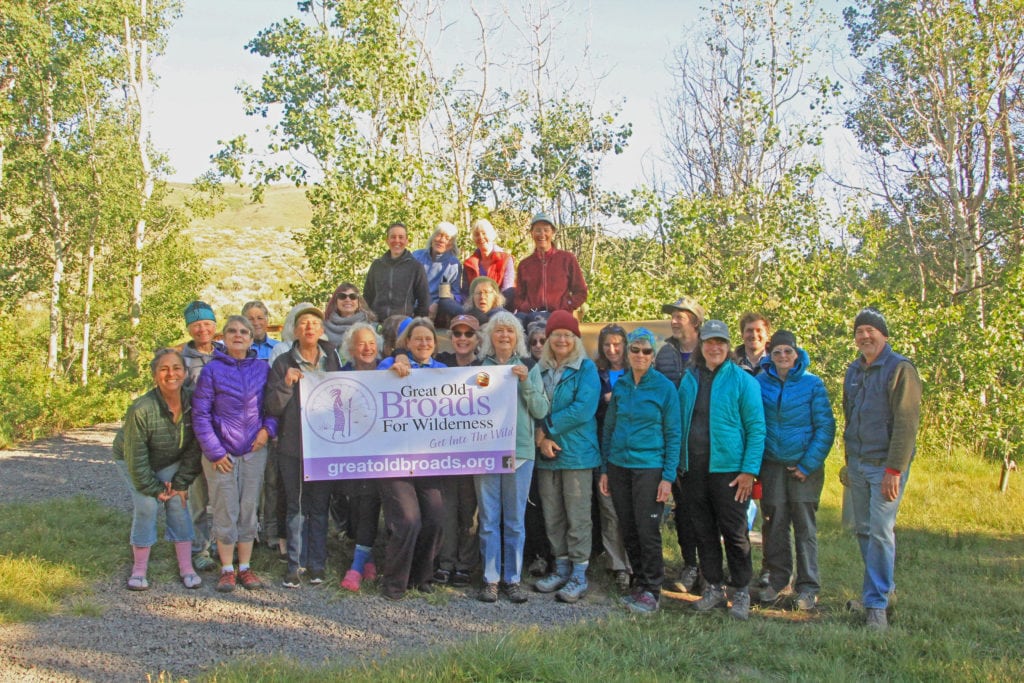This past June, 25 Oregon members of the Great Old Broads for Wilderness – a group that advocates for and celebrates America’s wild places — spent four days at Hart Mountain National Wildlife Refuge. It was a service and learning trip coordinated by Jeremy Austin of Oregon Natural Desert Association. We learned, hiked, soaked in hot springs, worked to protect high desert habitat. And most of all, we had fun.
We didn’t choose Hart Mountain for this gathering by chance. We wanted to learn about and experience how an ecosystem responds to the removal of livestock. After over 20 years with no grazing, not to mention the amazing geology, wildlife and hot springs, Hart Mountain was a natural fit.

Carol Savonen, center in blue, joined with her fellow Great Old Broads for Wilderness recently to volunteer for and explore the Hart Mountain National Antelope Refuge.
Day 1 was for traveling and exploring the refuge. Some climbed the high ridges looking for rare plants. Others explored rock art at Petroglyph Lake or the lush wildflowers in the local riparian areas. Jeremy welcomed us and gave us some background on the long weekend to come. We worked around the campfire that first evening to assemble thousands of fence tags to be put on fence the next day as part of our service work.
For the service work day, about half of us chose to cut down juniper on the west side of Hart Refuge, where the plant has been rapidly expanding due to fire suppression. Historically, junipers were not as omnipresent because natural, periodic wildfires kept them in check. Junipers tend to take over bunchgrass and sage habitat, crucial to the native pronghorn and dwindling populations of sage grouse. We armed ourselves with gloves, bow saws and big loppers and set to work cutting down medium and small juniper. By the time the morning was over we were covered with dust and pitch and were quite happy and tired. Jeremy then guided us on a scramble up DeGarmo Canyon, a wonderland of columnar andesite pillars and at the end, a waterfall!
The other half of the Broads group joined Hart Refuge Manager Jeff Mackay to flag the south boundary fence of the refuge with wildlife markers. This group braved a long, arduous trip to the south boundary in 4WD refuge vehicles on almost nonexistent two-track roads. The ride allowed the group to see a little-visited part of the refuge. The Broads festooned a couple of miles worth of wire fence with white plastic tag markers to help Greater sage grouse and other animals see the fence and avoid flying into it.
Back at camp that evening, Julie Weikel and Helen Harbin, two of the three who appeared in the film “Sagebrush Sisters,” talked about their 2015 walk between Hart Mountain and Sheldon National Wildlife Refuge in Nevada. We learned why it is so important to expand habitat protection for wildlife in “the land between” the two refuges, a migration corridor and critical habitat for pronghorn and sage-grouse.
On the third day, Jeff Mackay talked about the history of land management at what’s known as the Sheldon-Hart Mountain Refuge Complex. Cattle were removed 20 years ago from the Hart Refuge. Since then, aspen are reproducing again. Native forbs, shrubs and bunch grasses have returned in force. Bird diversity is up. We also heard from Phillip Street, a University of Nevada-Reno doctoral candidate of sage-grouse about his research. ONDA Oregon Desert Trail Coordinator Renee Patrick stopped in to tell us about her work advocating for (and hiking!) the 750-mile Oregon Desert Trail, which traverses some of the most spectacular natural areas of the state’s dry side, including Hart Mountain National Antelope Refuge, Steens Mountain and the Owyhee Canyonlands.
As the weekend came to an end, we all reflected on the depth of the information presented by the speakers, the field trips and the power of nature to heal impacted areas. We were inspired by the side trips to canyons, homesteads and playas during one of the best spring wildflower blooms in recent memory. But perhaps the greatest sense of satisfaction came in our ability as a group to volunteer and assist the U.S. Fish and Wildlife Service in service projects on our public lands. Whether we were getting down on hands and knees to cut juniper or taking the long, rough roads to the refuge boundary to mark fence lines with wildlife flags, at the end of the day, we all were walking away smiling.— Carol Savonen